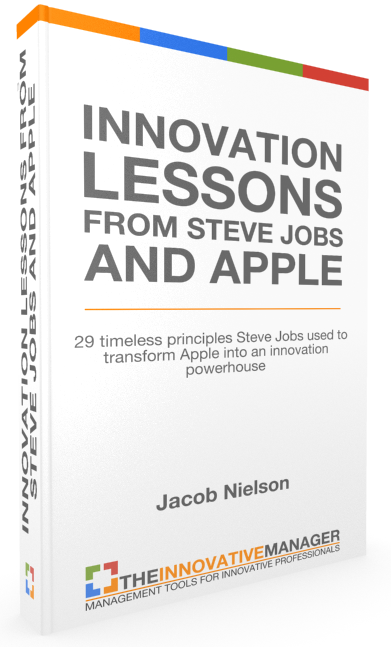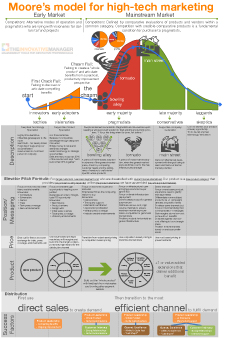To follow along in Excel, you can order my Strategic Planning Excel Template for $39.
Strategic planning and innovation for most companies usually involves leaving the office for a day at a fun resort “off-site,” brainstorming a few ideas, writing them down, hanging the mission statement on the office wall when you get back and putting the winning strategy, ideas and objectives into a binder that nobody looks at ever again. Sound familiar?

FREE VIDEO TRAINING FOR INNOVATORS
Over 100 Slides Free and Downloadable as a PDF
Fortunately there is a [much] better way. And the heart of this method is best explained in Japanese.
Hoshin Kanri.
That’s it.
Literal translation: Ho = method; shin = compass needle; kanri = management or control. Other translations include “guiding light.”
In other words, a method to manage or control the direction of your organization or to give it a “guiding light”. That sounds good to me. So let’s dive in to see how it works…
Fundamentals of A Strategic Plan
Properly planning and executing a project – whether that project is a business or launching a product within that business – starts with having measurable objectives. Having measurable objectives requires having an overall winning strategy. Having an overall winning strategy requires having a clear goal. Having a clear goal requires having an inspiring mission to serve a market. And having an inspiring mission to serve a market starts with knowing the core passions and competencies within you and the people in your business.
Make sense? Here’s a re-cap:
When done thoughtfully, this list of items comprises the soul of your organization and outlines it’s future. But just listing these doesn’t mean your business will actually accomplish it’s goals or mission. To ensure that happens, the daily tasks of each individual in the organization must be aligned with these overall goals. This is where project management comes in…
Every successful project embodies an objective in mind. To achieve that objective you will need to deploy a number of tactics. Once the tactical approach is decided, that will dictate the action items (or “to-do’s”) you will need to do on a daily basis.
Here’s a summary:
Now we can tie the two together:
To be clear, here is what I mean by each step:
- Your core passions and competencies
- This is what makes you uniquely qualified to start, build, grow and succeed in the market you’ve chosen to serve. You better be really passionate about it or someone else who is will outdo your efforts every day of the week.
- For example, Walt Disney World Parks and Resorts has three things that make them uniquely qualified to serve their market: 1) Animatronics and show design, 2) Storytelling, story creation and themed atmospheric attractions, 3) Efficient operation of theme parks. For more information, see this article on core competencies in Wikipedia.
- Inspiring Mission to Serve A Market
- This is your rallying cry of service to your current or would-be customers. It describes what you are going to do and for whom. Whether you are trying to cure cancer or feed busy workers during lunchtime, your mission is to meet their needs. Period.
- For example, Nike‘s mission statement is: “To bring inspiration and innovation to every athlete in the world.”
- Clear Goal(s)
- This is what success looks like to you and your business. It could be a revenue target, a market share target, a profitability target, website traffic, etc. Whatever it is, try to make sure it follows the S.M.A.R.T. (specific, measurable, attainable, relevant, time-bound) framework.
- For example, your business’ clear goal could be to achieve $5M in total revenue within 3 years.
- Winning Strategy
- This is the general statement or set of statements that explain how you will achieve your goal. The winning strategy should leverage your core passions and competencies and explain the trade offs your business will make to win customers versus the competition. For more background on business strategies such as cost or benefit leadership, see this post
- For example, your business’ winning strategy could be to become the premium (benefit leadership) provider of athletic apparel
- Measurable Objectives
- Measurable objectives are the specific and time-bound objectives you need to achieve in order to execute your strategy and accomplish your goal. Measurable objectives outline what you will do with which resources and by when.
- For example, if you were Nike one objective you might have is to launch a premium sport-based smart watch in 2015 through a partnership with Apple. In this example, the what = launch a premium sport-based smart watch, the resources = a partnership with Apple and the when = in 2015.
- Relevant Tactics (or Key Performance Indicators, KPI’s)
- Relevant tactics outline the specific ways in which you will achieve the measurable objectives.
- For example, if you were Nike and one objective was to launch a premium sport-based smart watch in 2015 through a partnership with Apple, one tactic you may need to deploy is to create a partnership agreement with Apple to co-develop the smart watch. Another potential tactic under that objective could be to incorporate Nike+FuelBand functionality into the smartwatch design. Another possible tactic could be to incorporate atomic time calibration into the design. All of these are tactical plans toward reaching your stated objective of launching a premium sport-based smart watch in 2015 through a partnership with Apple.
- For other areas of the business that are more driven by KPI’s, this is the appropriate level for including KPI’s as a part of or substitute for tactics. For example, one tactic might be to increase on time delivery to 90% or higher. This tactic is essentially the same as a KPI target and can be included at this level in the strategic planning process.
- Action Items
- Now we get to where the rubber finally meets the road. Action items are what you put on your to do list as things you actually have to do. All the previous work was simply to fine tune the course of your business to ensure what you do everyday matches what where you want to go and what you want your company to achieve.
- For example, if you were Nike and one tactic was to create a partnership agreement with Apple to co-develop a smart watch, an action item you will need to do is to pick up the phone and call someone at Apple about the idea. Another action item under that tactic could be to draft an outline of the partnership and the proposed terms. All of these fall into the “point of impact” where you actually have to gather inputs, create something new and generate an output.
Once each of these items is defined and communicated to the teams in your business, you can create a strong linkage between the tasks done on a daily basis and accomplishing the overall mission of the business.
This process is exactly what Hoshin Kanri is all about – creating a strategic plan that aligns the actions of the entire organization toward achievement of the business’ goals.
The next steps in the strategic planning process are all about capturing these ideas, communicating them to the broader organization and setting up proper follow-through procedures.
Capturing The Strategic Plan
One of the best tools to come out of the Lean revolution in Japan (“lean” and “hoshin kanri” management principles originated with Toyota and the Toyota Production System) was the simple to use tools for capturing strategic plans. The first is called the X-Matrix. A blank version is below:
You’ll notice that this sheet has spaces for capturing goals, strategies, objectives and tactics but leaves out core competencies and mission statements. For this reason, I created a custom template for capturing these items in Excel. See below:
I’m calling this sheet the Strategic Planning Dashboard. This sheet will help you systematically think through the purpose of your business and how you will succeed and achieve your goals. Steps labeled 1, 2 and 3 are all work that should be done prior to filling out an X-Matrix. You need to know why you are qualified to serve your market (core passions and competencies). You also need to determine who it is you serve and what it is you help those people achieve (job to be done). With those things as background you can create an effective mission statement that encompasses your passions, competencies, purpose and general strategy.
The first three items are the heart and soul of your organization. If you don’t have those figured out first, the rest of the steps will be a waste of time. Be sure to fill them out!
Your 3-5 Year Goals, Strategies and Objectives
Once you’ve identified your business purpose, it’s time to craft the 3 or 5 year plan. Many organizations tout the fact that they have a 5-year plan. Often those 5-year plans consist of little more than 5 years of forecast revenues which the company may or may not know how to achieve. In Hoshin Kanri strategic planning, the guess work is removed and as a business leader you must think through the specifics of how your business will reach it’s goals…goals that must be defined explicitly.
Going back to the definition of a goal above, determine what it is you want your business to achieve and type them into the space on the strategic planning dashboard and notice that those goals will automatically populate into the Level 1 X-Matrix.
Also, once you’ve entered in your strategic plan and this years objectives, those will automatically copy into the other sections of the Level 1 X-Matrix. See diagram below for how these fit together:
In some cases if your organization has multiple divisions or large departments that encompass multiple teams, you may need to deploy additional layers of X-Matrices to account for the added organizational layers. When this happens all you do is rotate items from the higher level X-Matrix into the lower level matrix and create the new strategies and tactics specific to that division.
Once the X-Matrix (or matrices) are filled in, you then need to utilize the Action Plan sheet which is the bridge between planning and doing. Only those resources (usually people) who have a solid dot above their name on the X-Matrix (signifying primary correlation to achieving an objective) should get an action plan.
When filling out the Action Plan, notice that there are open spots for the tactics to go which then have 10 action items each. Ten action items for each tactic is not a magic number and should be adjusted according to the number of action items needed to fulfill the tactic.
Once you’ve put all these items down on paper and committed to them, the next thing you’ll need is an effective communications and follow-through plan.
Review and Follow Through On Your Strategic Plan
The key to successfully making the strategic plan stick is two things: regular follow up and review. This is the part where many organizations drop the ball when it comes to strategic planning. And it’s understandable because few people like filling out regular reports of how things are going nor being asked to provide status updates on their daily or weekly activities. But from the experience of Toyota and many other companies who have implemented these tools, the benefits of regular follow up and review far outweigh the costs. The good news is that these follow-up and review sessions do not need to be painful and in some cases should take no longer than 30-60 minutes per month of time. Here’s how you can set these up to be as painless as possible for your business.
Action Items Review and Follow Up
For teams with action plans, the review process is as simple as scheduling a regularly occurring monthly meeting with each person listed as an owner invited to attend. The format of the meeting is to simply walk through each tactic and action item on the list and have each owner provide an update for the previous month. Is the action item on track, at risk of slipping, or behind? Team members should be encouraged to speak freely and any time something is reported to be at risk or behind the team should briefly discuss ways to get that item back on track.
Strategic Plan Review and Follow Up
On an annual or semi-annual basis the overall strategic plan of the business should be reviewed and updated as necessary. Team leaders should report their progress toward achieving the tactics and objectives they were assigned and business leaders should discuss whether the strategies are being executed effectively and helping to reach the goals. Each layer of the X-Matrix should be thought of as a cascading set of business hypotheses that are being evaluated at each review. Sometimes the strategies may not be the correct strategies to achieve the goals. Or the problem could be in the objectives and tactics. If not then the issue could stem from lack of progress with regards to the action items. Whatever the problem may be, by using this framework you will be able to systematically troubleshoot your business and pinpoint the specific needs of the business in order to succeed.
It’s important to note that these are living documents that should be updated as a team at each review. If it looks like something is not working well, adjust the plan to address it. If on the other hand it looks like you are on track to meet your goals and you are confident they can be achieved then leave the strategies, objectives and tactics alone and consider moving the goal higher.
Conclusion
As you utilize these tools you’ll start to find that each team member has a crystal clear idea of what’s expected of them and why their role is so important to the overall business. This not only boosts productivity but also boosts morale and helps teams collaborate more cohesively together. At the end of the day that’s exactly what you want – productive teams working cohesively together to solve the challenges your business faces so the organization can meet its goals and fulfill it’s inspiring mission to serve.

























The best strategic planning process presentation I have every encountered. Most are dull, long and boring. This guide put all the pieces together and gave me the big picture. Finally! Thanks so much for sharing.
It s very interesting . Tanks for sharing
2 Thumpos up!!
I’ve used the traditional Hoshin Kanri a few times now and the problems often encountered is the second level; i.e. the ‘strategic plan’ in the level 1, or the next years objectives in the level 2.
Whilst companies often have clear strategic long term goals, and can generally form structured SMART work streams for the bottom level; they often create the second level to simply satisfy the need of the matrix itself.
Wanting to use it again recently for strategy planning but also improvement projects we call work streams, I created a matrix where the second level used The 21 Keys to Workplace Improvement by Kobayashi. That way a company can focus not only on its strategic goals but drive the improvement activities needed to support them.
Concentrating on just a few of the Keys to start with, say Right First time, Reduction in Waste and Visual Management in our case, meant we had a much clearer link upstream and downstream from the 21 Keys, and gives us a clear measure since the Keys are very specific.
As progress is made the other Keys come in to play for the short, medium and long term goals.
There are a few other tweaks in the matrix we’re using, but I’d be interested in comments on my approach.
This is AMAZING! Thank you (I apologize for the caps…I am so grateful for this presentation.
very interesting. thanks a lot